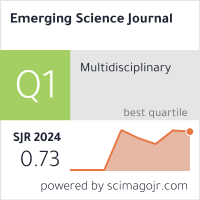Factors Influencing the Perception of Corruption in the Countries of the European Union
Downloads
Objectives: The European Union regularly publishes reports on corruption as part of its Eurobarometer surveys. These report on the opinions of European citizens regarding corruption and the presence of corruption they perceive. Based on survey data from 2008-2022, this study examines the perception of corruption in EU member states. Methods: As a method, the authors use statistical tests. They examine the differences between geographical regions and created country clusters to examine the effect of geographical location on the perception of corruption. They managed to show a difference between north and south. Findings: Based on the results, the role of the cultural and historical background is the most significant in the perception of corruption. Other influences, such as democratization, play a role in shaping opinions. However, the impact of the anti-corruption fight is evaluated independently of the region. It is also a common opinion that corruption cannot be eradicated. Novelty: This study provides a structured approach to analysing corruption perception across regions, emphasizing statistical validation. The findings contribute to understanding the persistence of corruption perception and highlight key influencing factors.
Downloads
[1] Transparency International. (2023). Financial Statements for the Year Ended 31 December 2022. Transparency International, Berlin, Germany. Available online: https://files.transparencycdn.org/images/2022-Financial-Statements.pdf (accessed on May 2025).
[2] European Commission (EC). (2023). Citizens' attitudes towards corruption in the EU in 2023 (Special Eurobarometer 534). Directorate General for Migration and Home Affairs Publications Office, Brussels, Belgium. doi:10.2837/439726.
[3] Radó, A. (1942). Foreign words dictionary (10th ed.). Lampel R. (Wodianer F. and His Sons). Available online: https://mek.oszk.hu/13600/13648/13648.pdf (accessed on May 2025)
[4] Nagy, G. (2018, January 31). Measuring the concept of corruption and its impact. Transparency International, Berlin, Germany. Available online: https://transparency.hu/wp-content/uploads/2018/02/A-korrupcio-fogalma-merese-%C3%A9s-hatasa.pdf (accessed on May 2025).
[5] Yunan, Z. Y. (2021). Does corruption affect Islamic banking? Empirical evidence from the OIC countries. Journal of Financial Crime, 28(1), 170–186. doi:10.1108/JFC-06-2020-0101.
[6] Joseph, J., & Smith, C. M. (2021). The ties that bribe: Corruption’s embeddedness in Chicago organized crime*. Criminology, 59(4), 671–703. doi:10.1111/1745-9125.12287.
[7] Khan, S. (2022). Investigating the Effect of Income Inequality on Corruption: New Evidence from 23 Emerging Countries. Journal of the Knowledge Economy, 13(3), 2100–2126. doi:10.1007/s13132-021-00761-6.
[8] Setor, T. K., Senyo, P. K., & Addo, A. (2021). Do digital payment transactions reduce corruption? Evidence from developing countries. Telematics and Informatics, 60, 101577. doi:10.1016/j.tele.2021.101577.
[9] Wolters Kluwer (2012). Act C. The Criminal About the Code. Wolters Kluwer, Illinois, United States. Available online: https://net.jogtar.hu/jogszabaly?docid=a1200100.tv (accessed on May 2025).
[10] Engels, J.I. (2016). The Corruption History. Corvina Publishing, Budapest, Hungary.
[11] Wax, E., Braun, E., & Wheaton, S. (2023). 11 key Qatargate players—Where are they now? Politico, Virginia, United States. Available online: https://www.politico.eu/article/qatargate-corruption-scandal-13-key-players-six-months-on-european-parliament/ (accessed on May 2025).
[12] Stolton, S. (2023). New York Times sues EU over von der Leyen's Pfizer texts. Politico, Virginia, United States. Available online: https://www.politico.eu/article/new-york-times-sue-european-union-ursula-von-der-leyen-pfizer-texts/ (accessed on May 2025).
[13] Burns, T. (1961). Micropolitics: Mechanisms of Institutional Change. Administrative Science Quarterly, 6(3), 257. doi:10.2307/2390703.
[14] Koselleck, R. (2010). Begriffsgeschichten. Suhrkamp Verlag, Frankfurt am Main, Germany. Available online: https://www.suhrkamp.de/buch/reinhart-koselleck-begriffsgeschichten-t-9783518295267 (accessed on May 2025).
[15] Fenyvesi, N. (2013). The one with a thousand faces corruption. Budapest Economic College Commercial, Catering and Tourism Damage Economics and Social Sciences Institutional Departmental Class, EPA, 1-27. Available online: https://epa.oszk.hu/03400/03448/00002/pdf/EPA03448_multidiszciplinaris_2013_1_017-027.pdf (accessed on May 2025).
[16] Keller, T., & Sík, E. (2009). Corruption perception, acceptance and practice. TÁRKI European Social Report, 167–182.
[17] Huff, E.B. (2013). The three-factor logic model of corruption. Criminal Law Review, 2013(1–2), 30–41.
[18] Al-Faryan, M. A. S. (2024). Agency theory, corporate governance and corruption: an integrative literature review approach. Cogent Social Sciences, 10(1). doi:10.1080/23311886.2024.2337893.
[19] Emordi, A. T. O., Ikedinma, H. A., & Eniola, M. A. (2024). Change through the ballot: Examining the 2024 constitutional democracy in Senegal. Human Nature Journal of Social Sciences, 5(3), 52–64.
[20] Johnston, M. (1986). The Political Consequences of Corruption: A Reassessment. Comparative Politics, Routledge, New Jersey, United Ststas. doi:10.2307/421694.
[21] Myrdal, G. (2017). Corruption: Its Causes and Effects. Political Corruption: Readings in Comparative Analysis. Routledge, New Jersey. doi:10.4324/9781003575658-72.
[22] Sharmeen, H. (n.d.). Mitigating white-collar crime in emerging economies: A case study of law enforcement agencies in Pakistan. International Journal of Applied Business and Management Studies, 9(1), 28–41.
[23] Trabelsi, M. A. (2024). The impact of corruption on economic growth: a nonlinear evidence. Journal of Social and Economic Development, 26, 953–962. doi:10.1007/s40847-023-00301-9.
[24] Italy On This Day's Editor. (2019). Salvatore Lima—Politician, Italy on This Day. Available online: https://www.italyonthisday.com/2019/01/salvatore-lima-corruption-Mafia-Italian-Sicilian-politician.html (accessed on May 2025).
[25] Ciancimino, M., & Licata, F.L. (2013). Don Vito. Quercus, London, United Kingdom.
[26] Kamm, H. (1982). Gunmen in Sicily kill high Italian police official. The New York Times. Available online: https://www.nytimes.com/1982/09/04/world/gunmen-in-sicily-kill-high-italian-police-official.html (accessed on May 2025).
[27] Capitani, G. (Director). (2007). Il generale Dalla Chiesa (Biography). Endemol Shine Italy, Mediavivere, Milan, Italy.
[28] Montalbano, W. D. (1987). 19 get life terms in Sicilian Mafia trial. Los Angeles Times. Available online: https://www.latimes.com/archives/la-xpm-1987-12-17-mn-29590-story.html (accessed on May 2025).
[29] Huff, E.B. (2023). The nature of corruption is a weed. Gradus, 10(1), 1-9. doi:10.47833/2023.1.ECO.001.
[30] Sík, E. (2001). The corruption size. Corruption in Hungary. Virágmandula Kft, Budapest, Hungary. Available online: https://www.libri.hu/konyv/csefko_ferenc.korrupcio-magyarorszagon.html (accessed on May 2025).
[31] Erzsébet, N., Tamás, V. B., & Ágnes, P. K. (2019). Scientific Reliability of International Corruption Rankings. Public Finance Quarterly, 64(3), 321–337. doi:10.35551/PSZ_2019_3_1.
[32] Portfolio.hu. (2021). Triple in a tie: The EU is the most corrupt country became Hungary according to Transparency International Index. Available online: https://www.portfolio.hu/unios-forrasok/20210128/harmas-holtversenyben-az-eu-legkorruptabb-orszaga-lett-magyarorszag-a-transparency-international-indexe-szerint-467224 (accessed on May 2025).
[33] Előd, F. (2020). With South Africa we avoided one level in corruption. Index, Budapest, Hungary. Available online: https://index.hu/gazdasag/2020/01/23/transparency_international_korrupcio_index_2020_korruptabb_lett_magyarorszag/ (accessed on May 2025).
[34] Murphy, K.M., Shleifer, A., & Vishny, R.W. (1993). Why is rent-seeking so costly to growth? The American Economic Review, 83(2), 409–414.
[35] Sachs, J. D., & Warner, A. M. (1997). Sources of slow growth in African economies. Journal of African Economies, 6(3), 335–376. doi:10.1093/oxfordjournals.jae.a020932.
[36] Neeman, Z., Paserman, M. D., & Simhon, A. (2008). Corruption and openness. B.E. Journal of Economic Analysis and Policy, 8(1). doi:10.2202/1935-1682.2013.
[37] Tanzi, V., & Davoodi, H. (1997). Corruption, Public Investment, and Growth. International Monetary Fund, New Hampshire, United States. Available online: https://www.imf.org/external/pubs/ft/wp/wp97139.pdf (accessed on May 2025).
[38] Wei, S. J. (2000). How taxing is corruption on international investors? Review of Economics and Statistics, 82(1), 1–11. doi:10.1162/003465300558533.
[39] Ahlin, C., & Pang, J. (2008). Are financial development and corruption control substitutes in promoting growth? Journal of Development Economics, 86(2), 414–433. doi:10.1016/j.jdeveco.2007.07.002.
[40] Yu, Z., Quddoos, M. U., Khan, S. A. R., Ahmad, M. M., Janjua, L. R., Amin, M. S., & Haseeb, A. (2023). Investigating the moderating impact of crime and corruption on the economic growth of Bangladesh: Fresh insights. International Area Studies Review, 26(2), 185–207. doi:10.1177/22338659221125696.
[41] Lederman, D., Loayza, N. V., & Soares, R. R. (2005). Accountability and corruption: Political institutions matter. Economics and Politics, 17(1), 1–35. doi:10.1111/j.1468-0343.2005.00145.x.
[42] Serra, D. (2006). Empirical determinants of corruption: A sensitivity analysis. Public Choice, 126(1–2), 225–256. doi:10.1007/s11127-006-0286-4.
[43] Thornton, J. (2012). Does Financial Development Reduce Corruption? SSRN Electronic Journal, 1-10. doi:10.2139/ssrn.1564445.
[44] Jungo, J., Madaleno, M., & Botelho, A. (2024). Financial Literacy, Financial Innovation, and Financial Inclusion as Mitigating Factors of the Adverse Effect of Corruption on Banking Stability Indicators. Journal of the Knowledge Economy, 15(2), 8842–8873. doi:10.1007/s13132-023-01442-2.
[45] Barik, R., & Lenka, S. K. (2023). Does financial inclusion control corruption in upper-middle and lower-middle income countries? Asia-Pacific Journal of Regional Science, 7(1), 69–92. doi:10.1007/s41685-022-00269-0.
[46] Song, C. Q., Chang, C. P., & Gong, Q. (2021). Economic growth, corruption, and financial development: Global evidence. Economic Modelling, 94, 822–830. doi:10.1016/j.econmod.2020.02.022.
[47] Thurnherr, S. (2023). About GCI. Global Corruption & ESG Indexes. Available online: https://risk-indexes.com/about-gci/#elementor-action%3Aaction%3Dpopup%3Aopen%26settings%3DeyJpZCI6NDIyMiwidG9nZ2xlIjpmYWxzZX0%3D (accessed on May 2025).
[48] WJP. (2022). World Justice Project Rule of Law Index 2022 Insights. World Justice Project. Available online: https://worldjusticeproject.org/rule-of-law-index/downloads/WJPInsights2022.pdf (accessed on May 2025).
[49] He, Y., Zhang, G., & Hsu, C.-H. (2021). Multiple Imputation of Missing Data in Practice. Multiple Imputation of Missing Data in Practice (1st ed.). Chapman and Hall/CRC, Florida, United States. doi:10.1201/9780429156397.
[50] van Buuren, S. (2018). Flexible Imputation of Missing Data, Second Edition. Flexible Imputation of Missing Data, Second Edition. Chapman and Hall/CRC, Florida, United States. doi:10.1201/9780429492259.
[51] Rahman, M. G., & Islam, M. Z. (2010). A decision tree-based missing value imputation technique for data pre-processing. Conferences in Research and Practice in Information Technology Series, 121, 41–50.
[52] Rahman, M. G., & Islam, M. Z. (2016). Missing value imputation using a fuzzy clustering-based EM approach. Knowledge and Information Systems, 46(2), 389–422. doi:10.1007/s10115-015-0822-y.
[53] Rawbone, R. (2013). The Oxford Textbook of Clinical Research Ethics. Occupational Medicine Oxford University Press, Oxford, United Kingdom. doi:10.1093/occmed/kqt041.
[54] Philip, A. (2006). Cluster analysis: Basic concepts and algorithms. Introduction to Data Mining. Panem Publisher Ltd. Kendal, England.
[55] Sajtos, L., & Mitev, A. (2007). SPSS Research and Data Analysis Manual. Alinea Publishing, Copenhagen, Denmark.
[56] Pólya, G. (1920). On the central limit theorem of probability theory and the moment problem. Mathematical Journal, 8(3–4), 171–181. doi:10.1007/BF01206525.
- This work (including HTML and PDF Files) is licensed under a Creative Commons Attribution 4.0 International License.




















